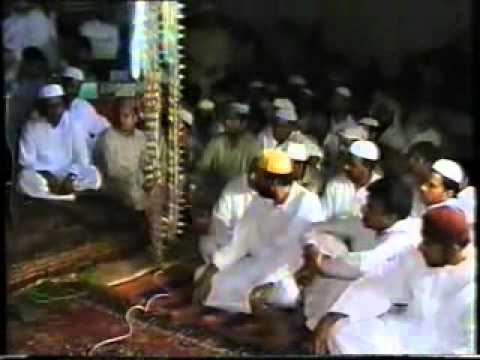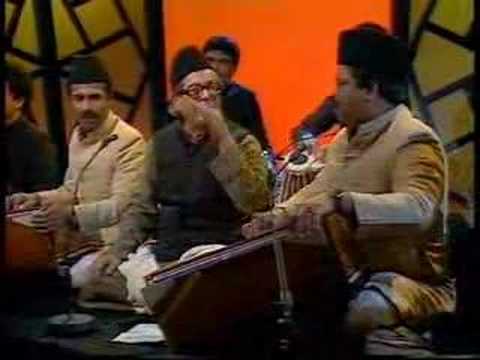Sabri Brothers
A compilation from various sites to make it easier for his admirers is my tribute to his genius.
The original Mr. India : for me Amir Khusrau is Mr. Hindustan.
Early Life
The life of Amir Khusrau is very well documented.
He was born in Patiali, which is in modern day Etah, U.P.in 1253. His father, Amīr Saifud-Dīn Mahmud, was a Turkish officer from Transoxania. His mother was the daughter of Rawat Arz,a Rajput and the famous war minister of the Delhi Sultan Balban.
His real name was Ab’ul Hasan Yamīn ud-Dīn Khusrau ( Khusrow is the anglicized pronunciation).
Khusrau in Dilli:
“How lovely is winter in India
that makes the home and outside look like a garden.”
Khusrau served under seven rulers of the Delhi Sultanate and was a prolific writer and wrote 92 books in all.
His masnawi ‘Qiran-us-Sa’dain’,written at age 36 earned him the post of poet laureate in court of King Kaikobad.
This is also called ‘Mathnavi dar Sifat-I-Dilli’ as it was his ode to the city of Delhi.
In ‘Mathnavi Nuh-Sipihr’ he pays further tribute to India’s birds and animals, flowers and trees, its languages and people.
In ‘Nuh Siphir'(songs of nine heavens) he talks of the religious and cultural plurality of Hindustan of those times. He talks of the mutual love between Hindus and Muslims and equates a Haji going toMecca with a Hindu pilgrim going to Somnath. He says:
“The Brahmans of India have greater wealth of philosophical thought than what Rumi had revealed to the World.
As nobody has tried to learn from the Brahmans, their learning has not been revealed to the world.”
(Indian Literary Criticism: Theory and Interpretation By G. N. Devy (Orient Longman))
Khusrau and Hazrat Nizamuddin :
Amir Khusrau came to the khanqah of Hazrat Nizamuddin Auliya (R.A) at a very early age and his love between the Peer o Murshid and his disciple is legendary.
“When Hazrat Amir Khusrau, went to see His Holiness Hazrat Syed Nizamuddin Aulia (R.A) for the very first time. It is said that young Amir Khusrau went to His Holiness khanqah, but did not enter and remained at the door by remarking,
“I shall select my “Peer/Spiritual guide” myself, and if it is bestowed with Divine Power he will converse with me even from distance.”
Thus sitting at the door he composed:
Tu an Shah-e-ke bar aiwan-e-qasrat.
Kabutar gar nashinad baz garded.
Gharib-e mustanande baradar amad.
Be ayat andar un ya baz gardad.
(You are such a mighty King that if a pigeon sits on your palace,
it turns into a hawk.
An outsider and a needy person has come at your door,
please let him know whether he should come in, or go away).
His Holiness who had supernatural powers sent him the following verse in reply:
“Biya yet andarun marde haqiqat,
Kibama yak nafas hamraz gardad,
Agar ablah buwad an mard nadan,
Azan rahe ki amad baz gardad.”
(The person who knows the truth may come inside so that we may exchange divine secrets between us for a moment.
If that person is ignorant, then he should return on the same path from where he has come here.)
Hazrat Amir Khusrau (R.a) immediately got up and ran to His Holiness and fell on his feet and wept!
His Holiness accepted him as his disciple (mureed) and gradually the two became inseparable. Haq”
( http://debatesangeet.blogspot.ae/2008/12/amir-khusro-i.html)
Hazrat Nizamuddin Auliya is quoted as saying that if Islam allowed it,he would have Khusrau and himself buried in the same grave after their death.
When Hazrat Nizamuddin passed away from this world Khusrau was away at Lakhnawati in Bengal on a mission on behalf of Sultan Mohammad Tughlaq. He rushed back to Delhi on hearing the tragic news and when he saw his Beloved Khwaja’s grave he “blackened his face and rolled over in dust in utter grief, tearing his garments.”
The following famous lines were recited by him at the spur of that moment:
Gori sovay sej par,
Mukh par daray kes;
Chal Khusrau ghar aapnay, saanjh bhaee chahu des.
( The Fair Maiden sleeps on her couch
Her beautiful face hidden by her tresses
Oh Khusrau let us go from here as dusk covers the four corners of the world
Amir Khusrau’s condition started deteriorating after this within 6 months of hazrat Nizamuddin’s on Friday 29th Ziq’ad 725AH/1325, he too left this world.
Khusrau and Qawwali:
Sufi ‘sama mehfils’ always used music as a means of inducing trance – ‘haal’
It is narrated that once Baba Farid Ganj Shakker came to visit Hazrat Nizamuddin Auliya at his khanqah in Dilli.
Hazrat Nizamuddin arranged for a sema mehfil for him with his chief disciple and acoomplished musician Amir Khusrau as the main singer. Baba Farid called out to him, “Oh Amir, I want you to start with a Qaul, today.”
Note : Qaul literally means a saying and this name is bestowed to the sayings of the Prophet pbuh.
The most popular qaul of the Prophet
“Man kunto maula,
Fa haza Ali-un maula ”
”whoever accepts me as a maul (master), Ali is his master too”.
was set to music by the genius Amir Khusrau on the spot. He added the famous tarana
“Dara dil-e dara dil-e dar-e daani.
Hum tum tanana nana, nana nana ray
Yalali yalali yala, yala ray ”
to give body and soul to the music and help to induce a trance.
I have 13 versions of Man Kunto Maula and my favourite versions are by Aziz Mian, Abida Parween, Ustad Shujaat Hussain and Abbas Ali Khan.
Ustad Shujaat Hussain sings qaul
Abida Parween sings qaul
Abbas Ali Khan sings Qaul
A favourite of mine – Bohat Ki Kathin Hai Dagar Pangat Ki sung by Jafar Husain Khan Badayuni
Amir Khusrau was entrusted with the work of developing Qawwali as a complete form of music and he selected 12 young students whom he called qawwal bachcha. It is through them that he presented Qaul Qalbana and other forms of Qawwali.
Munshi Raziuddin and his sons Farid Ayaz and Abu mohamed are descendants from those qawwal bachchas
Munshi Raziuddin sings Rang
Farid Ayaz and Abu Mohammed
Famous scions of the Qawwal bachcha also include Ustad Bahauddin Khan Qawwal and Ustad Meraj Ahmed Nizami
Ustad Meraj Ahmed sings Chaap Tilak
Khusrau and Indian Music
“A superb musician in his own right and credited with the invention of several musical instruments and with having laid the theoretical basis for much of Indo-Muslim music, Khusraw imparted to his ghazals a lilt and melody that have assured their inclusion in musical programs in India to the present day”
(Sangeet Natak, Volume XLII, No. 4, 2008)
Ghar Nari Ganwari – Munshi Raziuddin
Khusrau is said to be the inventor of the Sitar and the Tabla. In addition to these musical instruments, he is said to have been the originator of genres such as the tarana, khayal and the qaul. He is also said to have composed numerous new ragas.
It is said that he invented new ragas . At the time he came to the scene, Indian music had been slowly disappearing because of the advent of Persian influence. By an amalgamation of Indian and Persian music, Amir Khusrau gave Indian music a new lease of life.
Amir Khusrau is also credited with the creation of seventeen talas (patterns of rhythm) including the talas prevailing today such as teen tal, Jhoomra and Ara Chautala, and a number of raags including Yaman Kalyan, Sazgiri and Sarparda.
Though he himself modestly states that they already existed in Indo-Iranian music.
“Nevertheless, subsequent scholars consider Khusro to be the creator of a number of them. They point out that the Ragas mentioned are actually blends of existing Indian and Persian melodies. Yaman, for example, is an amalgam of the Indian Hindol (as it existed then) and the Persian Nairez or Nairiz. Similarly, Saazgiri comprises the ancient Indian forms of Purbi, Vibhaas, Gaud and Gunkali along with the Persian Ahang.”
(http://debatesangeet.blogspot.ae/2008/12/amir-khusro-ii.html)
Khusrau and the Tarana
Amir Khusro is said to have created six forms of music, namely Qaul, Qalbana, Khayal, Tarana, Naqsh, and Gul. The last two have lapsed into obscurity but the rest remain.
The word tarana itself means a song in Persian.
Though it is generally believed that Tarana is a composition of meaningless syllables followed sometimes by the bols (words coined to denote the various sounds of instruments) of the tabla and sometimes by Persian poetry, Ustad Amir Khan who devoted much of his life to music, discovered meanings in it.
According to Ustad Amir Khan
Tanan Dar Aa – Enter my body.
O Dani – He knows
Tu Dani – You know.
Na Dir Dani – You are the Complete Wisdom.
Tom – I am yours, I belong to you.
Yala – Ya Allah
Yali – Ya Ali
Other musicologists have also tried to explain their meanings, e.g:
Dar – Bheetar, Aandar (inside)
Dara – Andar Aa (get in or come inside)
Dartan – Tanke Aandar (inside the body)
Tanandara – Tanke Aandar Aa (Come inside the body)
Tom – Main Tum Hun (I am you)
Nadirdani – Tu Sabse Adhik Janata Hai (You know more than anyone else)
Tandardani – Tanke Aandarka Jannewala (One who knows what is inside the body) [2]
( http://qaul.blogspot.ae/2008/05/tarana-singing-ustad-amir-khan.html )
Khusrau and Basant
Khusrau and Riddles
Ek guni nay yeh gun keena,
Hariyal pinjray mein dedeena;
Dekho jadoogar ka kamaal,
Daalay hara, nikaalay laal.
One trickster performed this trick,
Inserted a (green) parrot into the cage;
Oh, what an act the sorcerer shows,
Puts in green, takes out red !
(http://www.ektaramusic.com/ak/riddle.html)
“Keh (say) Mukarni (denial) is an interesting genre of riddles played between two young women, where one of them describes something in a way that it is mistaken by the other girl as her beloved, and finally turns out to be something completely different.”
Lipat lipat kay wa-kay soyee,
Chhaati say chhaati lagakay royee,
Daant say daant bajay to taada.
Aye sakhi saajan? Na sakhi jaada!
(Cuddled up in his arms she slept,
Bosoms pressed against each other, she sobbed,
When the teeth started clattering, she saw.
Was it the beloved? No my dear.Winter!)
read more at
http://www.ektaramusic.com/ak/kemukar.html
Kah Mukarni
Khusrau and Braj Bhasha
In The poem Zihal e Miskin Khusrau wrote alternating verses in Persian and braj bhasha the prevailing local language of Delhi and its neighborhood.
Ustad Nusrat Fateh Ali Khansings Zihal e Miskin
For lyrics and translate please check :
Amir Khusrau was also instrumental i development of Hindi/Hindavi as he wrote in the language of the local people called Hindavi. This later developed into Hindustani.
Khusrau and folk songs
To this day no wedding is complete without the wedding songs composed by Amir Khusrau
Some of the songs in the beautiful voice of Kajjan Begum
Goondhon ri malan by Mehnaz Begum
Kaahe ko Biyaahi Bides by Malini Awasthi
Documentary on Amir Khusrau
Part 1
<
Part 2
Further Reading
1. http://www.svabhinava.org/abhinava/Dileep%20Karanth/AmirKhusrauIndianMusic.pdf)
2. http://lalioutloud.blogspot.ae/2010/09/of-qaul.html



















